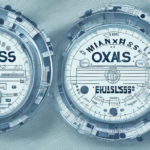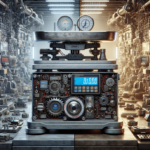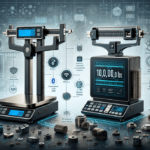Ohaus D51XW vs. CAS RW-L Series: Comprehensive Scale Comparison
Choosing the right scale is crucial for ensuring accuracy and reliability in your business operations. The Ohaus D51XW and CAS RW-L Series are two leading options in the market, each offering unique features tailored to different industries. This detailed comparison examines their performance, precision, design, ease of use, pricing, customer feedback, technical specifications, calibration procedures, durability, and maintenance requirements to help you determine which scale best fits your business needs.
Product Overview
Ohaus D51XW
The Ohaus D51XW is a legal-for-trade scale certified by regulatory bodies such as the National Type Evaluation Program (NTEP) and the International Organization of Legal Metrology (OIML). It is designed for industries like food processing, chemical manufacturing, and pharmaceuticals, where precision and regulatory compliance are paramount.
CAS RW-L Series
The CAS RW-L Series is tailored primarily for retail environments, including grocery stores, delis, and farmers’ markets. It features integrated label printing capabilities compliant with industry standards, making it ideal for high-throughput settings where speed and efficiency are essential.
Key Features
Ohaus D51XW
- High-Precision Load Cell: Ensures accurate measurements even under heavy loads.
- Large Backlit Display: Enhances visibility in low-light conditions.
- Dual-Line Alphanumeric Display: Facilitates easy data interpretation.
- Multiple Weighing Modes: Offers versatility for various applications.
- Optional Battery Operation: Provides continuity during power outages.
- Stainless Steel Platform: Ideal for environments requiring high hygiene standards.
CAS RW-L Series
- Built-In Thermal Label Printer: Streamlines labeling processes.
- Customizable Label Formats: Allows for tailored information display.
- Multiple Communication Ports: Includes Bluetooth and Wi-Fi for flexible connectivity.
- Intuitive Touch Screen Interface: Simplifies user interactions.
Performance and Precision
Weight Capacity and Readability
The Ohaus D51XW supports a higher weight capacity of up to 300 lbs with a readability of 0.01 lbs, compared to the CAS RW-L Series' 60 lbs capacity and 0.05 lbs readability. This makes the Ohaus D51XW suitable for applications requiring precise measurements of heavier loads.
Stabilization Time
The CAS RW-L Series boasts a faster stabilization time, displaying readings within 1 second compared to the Ohaus D51XW’s 2 seconds. This rapid response is advantageous for high-throughput retail environments where speed is essential.
Connectivity Options
The Ohaus D51XW offers USB and RS232 ports for data transfer, while the CAS RW-L Series includes Bluetooth and Wi-Fi capabilities, allowing for more flexible integrations with modern devices and systems.
Design and Durability
Build Quality
The Ohaus D51XW is constructed with rugged stainless steel, capable of withstanding heavy usage and exposure to harsh chemicals. It features an IP65 rating, indicating protection against dust and water splashes, making it suitable for harsh industrial environments.
In contrast, the CAS RW-L Series utilizes a robust plastic casing, protecting it from accidental drops and impacts. While lighter and more portable, it may offer less durability in extreme conditions compared to the stainless steel build of the Ohaus D51XW.
User Experience and Interface
Display and Navigation
The Ohaus D51XW employs a dual-line alphanumeric display with a menu-driven interface, simplifying navigation through its multiple functions. This setup is beneficial for users who require detailed information and multiple weighing modes.
The CAS RW-L Series features an intuitive touch screen interface, allowing users to easily customize label formats and print barcodes, PLUs, and other product information. This user-friendly design streamlines retail operations and reduces the learning curve for new users.
Pricing and Value
Budget considerations are significant when choosing between these scales. The Ohaus D51XW is priced between $600 and $1,000, reflecting its advanced features, higher weight capacity, and regulatory certifications. It offers value for businesses that prioritize precision, durability, and compliance.
Meanwhile, the CAS RW-L Series is more affordable, ranging from $200 to $500. This makes it an attractive option for small to medium-sized retail businesses that require reliable performance without the higher investment, balancing functionality with cost-effectiveness.
Customer Feedback
Customer reviews highlight the strengths and weaknesses of both scales. The Ohaus D51XW is praised for its accuracy, durability, and regulatory compliance, though some users find it expensive and less portable. The CAS RW-L Series receives positive remarks for its affordability and ease of use, but concerns are raised about its lower durability and accuracy compared to higher-end models.
Technical Specifications
| Specification | Ohaus D51XW | CAS RW-L Series |
|---|---|---|
| Capacity | 300 lbs | 60 lbs |
| Readability | 0.01 lbs | 0.05 lbs |
| Accuracy | ±0.02% of applied load | ±0.1% of applied load |
| Display | Dual-line alphanumeric | Touch Screen |
| Platform Material | Stainless Steel | Molded Plastic |
| Regulatory Certification | NTEP, OIML | N/A |
| Connectivity | USB, RS232 | Bluetooth, Wi-Fi |
| Price Range | $600-$1,000 | $200-$500 |
Calibration and Maintenance
Calibration Procedures
Maintaining accuracy through regular calibration is essential. The Ohaus D51XW requires a more intricate calibration process involving external weights and manual adjustments of internal settings, aligning with its high-precision standards. This process ensures the scale remains compliant with regulatory requirements.
In contrast, the CAS RW-L Series features an automatic calibration function, simplifying the process and reducing downtime for users. This ease of calibration is beneficial for retail environments where quick adjustments are necessary to maintain operational efficiency.
Maintenance Requirements
Regular maintenance ensures longevity and optimal performance of your scales. Both the Ohaus D51XW and CAS RW-L Series require routine cleaning to remove debris from the platform and display. The Ohaus D51XW may also need calibration verification every six months or according to regulatory guidelines, ensuring sustained accuracy.
The CAS RW-L Series benefits from frequent, though less intensive, calibration checks—typically on a weekly or monthly basis—to maintain accuracy. Additionally, its plastic casing requires careful handling to prevent physical damage, ensuring the scale remains in good working condition.
Durability in Various Work Environments
The Ohaus D51XW is built to endure challenging environments with its stainless steel platform and rugged construction, complemented by an IP65 rating for protection against dust and water. This makes it ideal for high-traffic industrial settings where durability and resistance to environmental factors are critical.
The CAS RW-L Series, while durable enough for typical retail environments, may not withstand the same level of physical or environmental stress. Its lightweight molded plastic body enhances portability but offers less protection against harsh conditions, making it best suited for indoor use in stores and markets.
Conclusion: Choosing the Right Scale for Your Business
The decision between the Ohaus D51XW and CAS RW-L Series hinges on your specific business requirements. If your operations demand high accuracy, robustness, and regulatory compliance—particularly in industries like food processing or pharmaceuticals—the Ohaus D51XW is the optimal choice. Its superior build quality and precision justify the higher investment for businesses that cannot compromise on these aspects.
Conversely, for retail environments that prioritize affordability, portability, and ease of use with integrated label printing, the CAS RW-L Series is more suitable. Its user-friendly interface and faster stabilization time enhance operational efficiency, making it a practical choice for high-turnover retail settings.
Pros and Cons
- Ohaus D51XW
- ⭐ High accuracy and precision
- ⭐ Durable stainless steel construction
- ⭐ Regulatory compliance (NTEP, OIML)
- ❌ Higher price point
- ❌ Less portable
- ❌ Complex calibration procedures
- CAS RW-L Series
- ⭐ Affordable pricing
- ⭐ Portable and lightweight
- ⭐ User-friendly interface
- ❌ Lower accuracy and weight capacity
- ❌ Less durable in harsh environments






















